Samedi, 28 février 2009
Traduction: [ Google | Babelfish ]
Catégories : [ Bière/Bath Ales ]
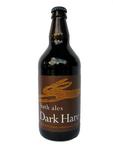
“We brew Dark Hare using a blend of dark roasted malts and old fashioned (and
rather famous) English hops called Fuggles.”
Just another stout, not sweet, quite bitter. Contains wheat and barley malt.
Bath Ales, Warmley, South Gloucestershire, England. 4.0% alcohol.
[ Posté le 28 février 2009 à 23:44 |
pas de
commentaire |
lien permanent ]
Adresse de trackback
https://weber.fi.eu.org/blog/Biere/Bath_Ales/dark_hare.trackback
Commentaires
Aucun commentaire
Traduction: [ Google | Babelfish ]
Catégories : [ Bière/Bath Ales ]
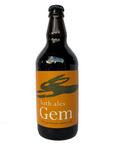
“We brew Gen using floor-malted Maris Otter barley and Goldings hops. …
Fine filtered…”
Just another ale with a strong malt taste. Made of wheat and barley malt.
Bath Ales, Warmley, South Gloucestershire, England. 4.7% alcohol.
[ Posté le 28 février 2009 à 23:44 |
pas de
commentaire |
lien permanent ]
Adresse de trackback
https://weber.fi.eu.org/blog/Biere/Bath_Ales/gem.trackback
Commentaires
Aucun commentaire
Traduction: [ Google | Babelfish ]
Catégories : [ Bière/Ridgeway ]
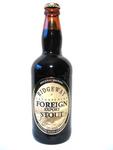
“Ridgeway FES bottle matures in a similar way to vintage port. Roasted malts
and leaf hops initially provide an aroma of breakfast coffee and fresh spices
that gradually fades to reveal licoricem caramel and raisin notes that are
products of the aging process. Beneath all this change sits a solid and
resilient backbone of bitter English hops.”
Smells of fresh dark bread. Tastes maybe of coffee, but definitely of caramel.
Very sweet and strong. Made of barley (Marris Otter malt) and oats.
Ridgeway Brewing, South Stokes, Oxfordshire, England. 8% alcohol.
[ Posté le 28 février 2009 à 23:42 |
pas de
commentaire |
lien permanent ]
Adresse de trackback
https://weber.fi.eu.org/blog/Biere/Ridgeway/foreign_export_stout.trackback
Commentaires
Aucun commentaire
Traduction: [ Google | Babelfish ]
Catégories : [ Bière/Ridgeway ]
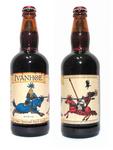
“Roast malts, whole English aroma hops and bottling with live yeast…”
The first sip tastes strongly of fresh white bread. It is slightly bitter.
Otherwise, it's just another ale. Made of malted barley and wheat.
Ridgeway Brewing, South Stoke, Oxfordshire, England. 5.2% alcohol.
[ Posté le 28 février 2009 à 23:41 |
pas de
commentaire |
lien permanent ]
Adresse de trackback
https://weber.fi.eu.org/blog/Biere/Ridgeway/ivanhoe.trackback
Commentaires
Aucun commentaire
Vendredi, 27 février 2009
Catégories : [ Cuisine/Glace ]
Recette trouvée sur healthy Cooking
recipes.
Ingrédients
- 2 œufs entiers
- 14 cL sucre en poudre
- 50 cL crème fluide
- 25 cL lait entier
- 2 c. à café sucre vanillé
Préparation
Fouetter les oeufs jusqu'à ce qu'ils moussent. Ajouter le sucre et le sucre
vanillé peu à peu tout en fouettant, puis ajouter la crème, puis le lait tout
en fouettant. Passer immédiatement à la sorbetière.
Commentaires
- La préparation est très mousseuse, et la glace reste molle même après 24h au
congélateur (à -18 °C).
- C'est trop sucré.
- La consistance en bouche n'est pas assez crémeuse (malgré la quantité de
crème), j'ai l'impression qu'il y a trop de cristaux de glace (ou des bulles
d'air gelées ?)
[ Posté le 27 février 2009 à 21:32 |
pas de
commentaire |
lien permanent ]
Adresse de trackback
https://weber.fi.eu.org/blog/Cuisine/Glace/glace_sans_cuisson.trackback
Commentaires
Aucun commentaire
Jeudi, 26 février 2009
Catégories : [ Bricolage | Jeux ]
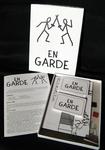
Knizia a publié en 1993 En Garde, un jeu de cartes qui
simule un duel d'escrime. Il a été réimplémenté en 2004 sous le nom de
Duell avec quelques cartes
supplémentaires, puis réédité en 2008, mais payer 30 EUR (ou 20 pour l'édition
de voyage) pour 25 cartes numérotées de 1 à 5, un plateau de 23 cases et 2
pions, ça me paraît de l'abus. Je ne suis pas un artiste, mais pour essayer si
le jeu est bien je me suis dit que je pourrais bien fabriquer les composants
moi-même.
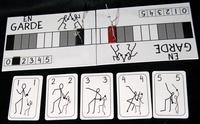
Les dessins sur les cartes viennent des cartes de l'édition 2008, d'où j'ai
simplement relevé la position des deux bretteurs sous forme de bonshommes
« bâtons ». Les cartes ont été imprimées
à grand'peine
sur des feuilles microperforées.
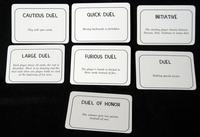
Le texte des cartes spéciales est une traduction de l'espagnol vers l'anglais
à partir de d'une autre version faite maison.
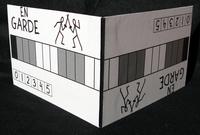
Le plateau est collé à la colle en aérosol sur du carton gris de 2 mm. Les
deux moitiés sont assemblées par du gaffer's tape. Il est un peu raté, les
deux moitiées ne s'assemblent pas correctement. La prochaine fois, je devrai
couper la surface du plateau après collage seulement.
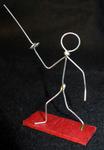
Les pions sont fabriqués à partir de fil de fer zingué de 0,9 mm de diamètre.
La tête et les bras sont d'une partie, le tronc une deuxième et les jambes une
troisième, et ont été soudées ensemble avec un fer à souder. Le socle est en
carton colorié au feutre. J'ai d'abord collé les bonshommes à la cyanoacrylate
sur le carton, mais ils n'ont pas tenu, je les ai recollés à la colle
universelle transparente (sans eau).
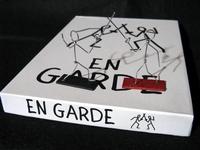
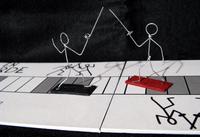
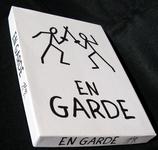
La boite est en carton gris d'1,5 mm. Les coins sont assemblés avec de
la bande adhésive transparente de base (qui ne tient pas bien), et la
couverture est collée encore une fois à la colle en aérosol.
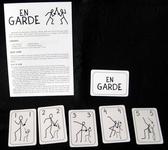
Les règles sont copiées de la version de Chris Lawson
publiée sur le web.
[ Posté le 26 février 2009 à 10:22 |
pas de
commentaire |
lien permanent ]
Adresse de trackback
https://weber.fi.eu.org/blog/Bricolage/en_garde.trackback
Commentaires
Aucun commentaire
Vendredi, 20 février 2009
Catégories : [ Râleries ]
Lorsque j'écoute mes podcasts préférés, je ne peux m'empêcher de me demander à
quoi ressemblent les présentateurs et à les imaginer. Dans l'ensemble, je suis
plutôt mauvais à ce jeu, puisque je les imagine tous vaguement comme moi
(jeunes et bruns).

Matthieu Vidard (La tête au carré, France Inter) est
un peu plus en chair (ça se voyait mieux sur une video
récente) et moins rasé que ce que j'imaginais.
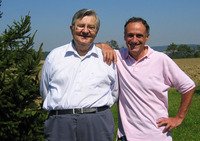
Jean-Marie Pelt (invité régulier de CO2, mon amour!, France
Inter) ressemble à l'image que je me fais de lui (plus très jeune, mais ça il
l'admet lui-même à l'antenne, et bien en chair), mais Denis Cheissoux
(présentateur officiel de l'émission) est beaucoup plus vieux et
grisonnant :)


Stéphane Deligeorges (Continent Science, France Culture) est un peu comme
l'Arlésienne, on a du mal à le voir (à gauche sur la photo de gauche), mais c'est
peut-être lui à droite sur la photo de droite. Ou pas.

Gareth Mitchell (Digital Planet, BBC) est roux, quelle surprise !
 Quant à Bill Thompson (commentateur régulier dans
Digital Planet), je ne l'imaginais pas vraiment, mais la barbe et les
cheveux longs sont néanmoins une surprise.
Quant à Bill Thompson (commentateur régulier dans
Digital Planet), je ne l'imaginais pas vraiment, mais la barbe et les
cheveux longs sont néanmoins une surprise.
[ Posté le 20 février 2009 à 17:04 |
2
commentaires |
lien permanent ]
Adresse de trackback
https://weber.fi.eu.org/blog/Raleries/mettre_un_visage_sur_une_voix.trackback
Commentaires
Stéphane Deligeorges
Commentaire N° 1, Gintas (Kaunas, Lithuania)
le 9 juin 2011 à 18:55
Commentaire N° 2, Matthieu Weber (Jyväskylä, Finlande)
le 10 juin 2011 à 16:09
Traduction: [ Google | Babelfish ]
Catégories : [ Informatique ]
I tried to use one of these wild devices to print a Letter landscape document
on microperforated Letter sheets… in an A4 world.
When the printer is set to use A4 paper, it won't pay attention to the
PostScript file telling it that the paper format is Letter. The result is
that the print would be correctly positioned on an A4 sheet, but is shifted up
the actual Letter sheet, because the letter sheet is aligned with the bottom
of the would-be A4 sheet.
The solution is to feed the beast only portrait documents, centered on an A4
page, then shift the document 2.5mm to the left to compensate for the fact
that it aligns the page's right border with the sheet's right border. This
gets it really centered on the Letter sheet (it should be 3mm to account for
the width difference between Letter and A4, but even A4 pages are shifted by
0.5mm; it would be too easy otherwise).
Finally, the bottom edge of the printed document is on the side of the back of
the beast (the one that is against the wall, opposite of the control panel).
This is important for the microperforated paper which has a smaller bottom
margin than the top margin.
[ Posté le 20 février 2009 à 17:04 |
4
commentaires |
lien permanent ]
Adresse de trackback
https://weber.fi.eu.org/blog/Informatique/ricoh_aficio_taming_the_beast.trackback
Commentaires
Commentaire N° 1, Tuuli Mustasydän (Edmonton, Canada)
le 21 février 2009 à 18:49
Commentaire N° 2, Matthieu Weber (Finlande)
le 22 février 2009 à 22:40
Commentaire N° 3, Tuuli Mustasydän (Edmonton, Canada)
le 22 février 2009 à 23:30
LPRng and Windows LPD Server
Commentaire N° 4, Blog & White
le 27 janvier 2010 à 14:36
Samedi, 14 février 2009
Traduction: [ Google | Babelfish ]
Catégories : [ Bière ]
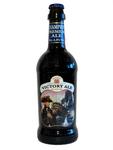
“brewed to celebrate the courage of Admiral Nelson and his crew… brewed
with Maris Otter pale and crystal malts and hopped with
English Goldings and American Liberty hops… peppery hops and bitter orange
aromas, balanced by fresh bread maltiness. Ideal accompaniment to stew and
gravy”
Quite bitter, maybe orangey, and a definite fresh bread flavour. Contains malted barley.
Batemans, Wainfleet, Lincolshire, England. 6.0% alcohol.
[ Posté le 14 février 2009 à 11:10 |
pas de
commentaire |
lien permanent ]
Adresse de trackback
https://weber.fi.eu.org/blog/Biere/victory_ale.trackback
Commentaires
Aucun commentaire
Mercredi, 11 février 2009
Catégories : [ Râleries ]
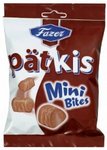
Certains noms et marques n'ont l'air de rien dans une langue, et prennent un
sens tout différent dans une autre. Je connaissais déjà l'exemple de la Honda
MR2, renommée Honda MR pour le marché francophone. Voilà les Pätkis Mini Bites
de Fazer dont le nom aurait besoin d'être repensé si Fazer avait l'intention
de les vendre à des francophones.
[ Posté le 11 février 2009 à 18:42 |
pas de
commentaire |
lien permanent ]
Adresse de trackback
https://weber.fi.eu.org/blog/Raleries/marketing_multilingue.trackback
Commentaires
Aucun commentaire
Vendredi, 6 février 2009
Traduction: [ Google | Babelfish ]
Catégories : [ Bière/Williams ]
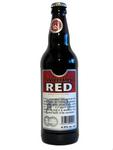
“rich ruby malt ale, medium dry, with hints of toffee and banana… fresh
spicy hops to give a zesty peppery backdrop”
Rather hints of red fruits than toffee, I'd say. But that's just me.
Williams Bros Brewing Co., Alloa, Scotland. 4.5% alcohol.
[ Posté le 6 février 2009 à 18:51 |
pas de
commentaire |
lien permanent ]
Adresse de trackback
https://weber.fi.eu.org/blog/Biere/Williams/williams_red.trackback
Commentaires
Aucun commentaire
Mercredi, 4 février 2009
Catégories : [ Cuisine ]
Deuxième expérience de yaourt.
Ingrédients
- 7,5 dL lait entier
- 2,5 dL yaourt turc 10% matière grasse
Préparation
Remplir le pot de yaourt et le verre doseur d'eau bouillante pour éliminer de
potentielles levures parasites (?). Battre le yaourt dans un verre doseur d'un
litre. Ajouter le lait peu à peu en mélangeant. Faire chauffer le mélange à
44 °C. Verser dans le pot. Placer le pot dans la
yaourtière et laisser reposer pendant 4
heures.
Commentaires
- Le yaourt a épaissi un peu mais reste très fluide. Il n'est pas granuleux
comme l'expérience précédente. Le passage
au réfrigérateur semble avoir eu une influence positive sur la gélification du
yaourt
- J'aurais dû passer la casserole à l'eau bouillante aussi, mais ça a marché
sans.
- Après réflexion, la yaourtière SEB semble ne rester allumée que pendant une
heure et laisse ensuite le yaourt refroidir lentement. C'est une voie à
explorer
[ Posté le 4 février 2009 à 23:25 |
pas de
commentaire |
lien permanent ]
Adresse de trackback
https://weber.fi.eu.org/blog/Cuisine/yaourt_2.trackback
Commentaires
Aucun commentaire
Mardi, 3 février 2009
Catégories : [ Cuisine/Chocolats ]
Dammenberg
Tummasuklaa 55% : très sucré
Anthon Berg Ecuador,
72% : amer, fleuri, astringent, darjeeling ?
Marabou Premium 86% : amer, pâteux
Fazer Thin Dark 70% : doux, biscuit, pâteux, truffé ?
[ Posté le 3 février 2009 à 23:28 |
pas de
commentaire |
lien permanent ]
Adresse de trackback
https://weber.fi.eu.org/blog/Cuisine/Chocolats/chocolats_10.trackback
Commentaires
Aucun commentaire
Lundi, 2 février 2009
Traduction: [ Google | Babelfish ]
Catégories : [ Cuisine/Chocolats ]
Riss Abinao, assemblage, Afrique, 86% : amer, cerise, amande amère
Riss Criollo, Cuba, 86% : amer et doux, très légèrement fruité (fruits séchés)
Riss Guanaja, assemblage de Criollo et Trinitario, 70% : piquant, légèrement
fleuri
Riss Cuba, 70% : doux, vaguement caramel
Riss Alpaco, Equateur : jasmin, orange, doux, thé vert
[ Posté le 2 février 2009 à 22:54 |
pas de
commentaire |
lien permanent ]
Adresse de trackback
https://weber.fi.eu.org/blog/Cuisine/Chocolats/chocolats_9.trackback
Commentaires
Aucun commentaire
Dimanche, 1er février 2009
Traduction: [ Google | Babelfish ]
Catégories : [ Livres/World of the 5 Gods ]
Sequel to Curse of Chalion
by Lois McMaster Bujold, published in 2003.
Ista, the mother of the royina of Chalion-Ibra, can't stand her too quiet life
in her castle. She decides to start a pilgrimage and get away from the place.
During the journey, she has strange dreams about a man lying on a bed with a
stream of light coming out of his chest and leaving through the door. On the
way Ista and her party are attacked by Jokonan soldiers who take her prisoner
for ransom. She is saved by a mysterious knight, Arhys, lord of the nearby
castle of Porifors. Ista quickly notices that Arhys never eats and never
sleeps at night. At the same time, Arhys' half brother Ilvin is near death,
and has been so for the last three months, only waking up briefly, on some
days. In a dream, the Bastard, god of demons gives her again the gift of
second sight she had in the previous story. Ista then discovers that Arhys is
actually dead, killed three months earlier by a Jokonan princess who stayed at
the castle on a diplomatic mission. The princess was inhabited by a demon, and
when she was killed the demon went into Arhys' wife, Cattilara, who was the
closest person. Cattilara's will was strong enough to force the demon to keep
Arhys' soul bound to his body, giving the illusion of life, while draining the
life from his half brother. Ista manages to get Arhys to talk to Ilvin
(Cattilara was preventing this to happen) and Arhys agrees he has to die for
good. But Ista notices that Arhys' soul cannot be taken by a god, condemning
him to damnation. Soon after, the Jokonans attack the castle, helped by Queen
Joen who appears to be a powerful sorceress, and controlling eighteen other
sorcerers. She demands Ista to be brought to her, as a first step to conquer
Chalion and Ibra. Her sorcerers make the siege of the castle impossible to
resist. During the night, Ista is visted again by the Father of Winter who
gives her the power to link her soul to Arhys and thus allow him to be taken
by his god when dying for good. Additionaly, the Bastard gives her the power
to eat demons and return them to hell. Arhys, immune to demons' magic, leaves
the castle at night in order to kill as many sorceres as possible and die
gloriously, while Cattilara and Ilvin give him their life energy and absorb
his wounds. After that, Ista and Ilvin go and surrender to the Jokonans. When
taken to Joen, Ista absorbs her demon and the ones of her other sorceres. The
Jokonans are then swept away.
[ Posté le 1er février 2009 à 23:25 |
pas de
commentaire |
lien permanent ]
Adresse de trackback
https://weber.fi.eu.org/blog/Livres/World_of_the_5_Gods/paladin_of_souls.trackback
Commentaires
Aucun commentaire
Catégories : [ Cuisine ]
Premières expériences de yaourt en suivant les instructions de
l'INRA.
Ingrédients
Préparation
Battre le yaourt dans le pot d'un litre. Faire chauffer le lait à une
température telle que le mélange lait plus yaourt est aussi proche que
possible de 45 °C, mais inférieur à cette température (T = (45 - 0,2 x température
du yaourt) / 0,8 ). Verser un peu de lait chaud sur le yaourt et battre, puis
verser encore un peu de lait, etc. Ceci devrait permettre de mélanger le
yaourt au lait sans « cuire » le yaourt (et tuer les ferments). Placer le
pot dans la yaourtière et laisser
reposer pendant 3 – 4 heures.
Commentaires
- La température initiale était de 43 °C et la température finale de 44 °C, le
système de chauffage de la yaourtière est donc suffisant.
- La texture du yaourt, en revanche, est très fluide et granuleuse. Quelqu'un
a mentioné la présence de levures (non désirées) qui ont donné cet effet.
Sinon il peut s'agir du temps de préparation qui n'était pas assez long (3h30)
- On pourrait ajouter du lait en poudre dans le yaourt (mais je trouve que
c'est de la triche, après tout Valio arrive à faire son yaourt sans lait en
poudre), sinon on peut faire réduire le lait pour diminuer sa teneur en eau.
Faire bouillir le lait un certain temps est la méthode classique, mais elle
consomme beaucoup d'énergie. Faire bouillir à basse pression devrait permettre
de réduire la température d'ébullition et économiser beaucoup d'énergie, mais
je n'ai pas le matériel nécessaire.
[ Posté le 1er février 2009 à 22:53 |
pas de
commentaire |
lien permanent ]
Adresse de trackback
https://weber.fi.eu.org/blog/Cuisine/yaourt_1.trackback
Commentaires
Aucun commentaire























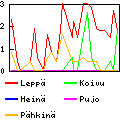





Hi, I am a "France Culture" radio fan and I try to learn French. I am glad you've mentioned Stéphane Deligeorges in your blog, because I like "Continent Sciences". Cheers, Gintas